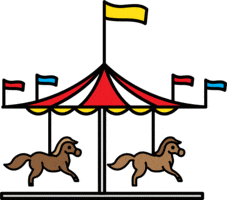Rounding Large Numbers Worksheets
When we tackle this topic, I like to encourage students to use an English language convention of using commas in large numbers. Every third digit found in a very large number should have a comma to clearly allow readers to see that comma separating three digits. To this point we have been rounding values to give us either a general idea of the data or an easier number to work with. The same general strategy that we have used with 2- and 3-digit numbers applies to quantities that contain amount in the billions and trillions to. The most important thing to get across to students is to understand how to locate the digit of interest and then everything else you do is completely downhill. That is because the procedure we are accustomed to follows the same technique. These worksheets and lessons help students become comfortable with rounding very sizable values.
Aligned Standard: 4.NBT.A.3
- Very Large Numbers Step By Step Lesson- This is a two-page stepped lesson. You start with ten-thousands and move to millions.
- Guided Lesson - We added decimals to throw in a bit of hesitated learning.
- Guided Lesson Explanation - Every step of the process is outlined and then acted to explain further.
- Nearest Hundred-Thousand Worksheet 1 - There are mixed decimals scattered through out this.
- Nearest Hundred-Thousand Worksheet 2 - See if you get the concept of the hair dryer.
- Answer Keys - These are for all the unlocked materials above.
Set Place Value Rounding Worksheets
Make sure to remind students the importance of commas in large integers when rounding.
- Nearest Ten-Thousand Worksheet 1 - Round the following decimals to the nearest hundred thousand.
- Nearest Hundred-Thousand Worksheet 2 - Determine the place value of every number.
- Nearest Million Worksheet 1 - We look to the place value to the right of that place thousands). If that number is 5 or greater, we round up. Otherwise, the number stays as is.
- Nearest Million Worksheet 2 - All the number to the right of that place turn to zero.
Mixed Place Value Practice Worksheets
We three activities in one for each sheet here.
- Mixed Large Numbers 1 - Find the place value we need to round to.
- Mixed Large Numbers 2 - Don't forget to make all the lower places zeroes
- Mixed Large Numbers 3 - All over the place with these.
- Mixed Large Numbers 4 - Round the following values to the nearest hundred thousand.
How to Round Very Large Numbers

In science and many areas of finance we often work with huge numbers. Making sense of this data can be cumbersome and at the same time necessary to make conclusions or decisions based on it. Large or complex numbers are difficult to work with. Often times, they do not give you the exact value or the exact answer you have been searching for; in fact, you get a large, overly crowded number as an answer. In such a case, an old concept of mathematics comes for rescue, and that concept is the rounding off large numbers.
So how can you round off very large numbers? It all starts with understanding how accurate you need to be. Accuracy matters a great deal and is often a forgotten issue. For instance, what if you were to want to understand how many middle boys basketball players were in your county and you did an exact count and came to the conclusion that there were 243. A reporter later was doing a count and asked you roughly how many of these players there was. If you rounded to the hundreds place it would be 200, but if you rounded to the tens place it would be much more accurate at 240. The first attempt of rounding yielded 43 non-accounted for players, but the second attempt only was off by 3. The higher the value you are asked to round to yields less accurate reflections of the actual data. Consider the place value that is required to maintain a level of significance when you round off a number. Most times you will be tasked with the accuracy, but there will be many times where this is left up to your discretion.
For example, if a problem asks you to round to the nearest hundred thousand (100,000) identify digit that identifies that place value within the number. Once you have located that specific digit, look just to the right of it. If the number nearest to the place value is 5 or above 5, the number is rounded up. For example, a number 67 is rounded off to the nearest ten as 70. If the number rounding off is less than 5, then you will round the number down. The number 24 is rounded down to 20. Now you could say that this all fine and well, but that doesn’t apply to very large number compositions. In truth, this simple concept of looking for a digit that is 5 or greater vs. 4 or less applies at any scale. It does not matter if you evaluating a 2-digit number or a 22-digit number.